Looking for doodle inspiration? Try sketching funny animal faces, zany llamas, or playful foxes with goofy tails. Mix it up with floral patterns, cheerful cacti, or wild mushrooms. Add flair by doodling pineapples in sunglasses, retro roller skates, or dreamy hot air balloons floating past mountain scenes. Whip up buzzing bees or abstract mandalas for some artsy vibes. There are even more cool and quirky ideas—each one just waiting to make your page pop if you stick around!
Key Takeaways
- Explore animal and nature doodles like whimsical foxes, honeybees, and leafy motifs for playful inspiration.
- Try floral and botanical sketches such as cacti, mushrooms, and pineapples to add vibrant natural elements.
- Create geometric mandalas and abstract face line art for structured or expressive doodle styles.
- Experiment with color, line thickness, and textures to bring depth and unique flair to your drawings.
- Combine everyday objects and imaginative scenes, like book stacks, lanterns, or hot air balloons, for endless creative possibilities.
Animal Doodles
Lions, penguins, and even the occasional wobbly puppy—animal doodles are where creativity can run wild and sometimes a little silly.
The best starting point for anyone itching to Spark Your Creativity is using basic shapes—think circles, ovals, and rectangles—for sketching a cat or maybe a quirky fox. From here, artists add simple lines for legs, or zigzags for wild fur, letting their own style shine through.
Not only do you get to draw adorable creatures, but you also practice new styles, like turning a clumsy elephant into a cartoon or making a bird look super realistic.
These doodles aren’t just for personal sketchbooks, either; sharing them online spreads the joy and inspires other doodlers to join the fun.
Floral Patterns
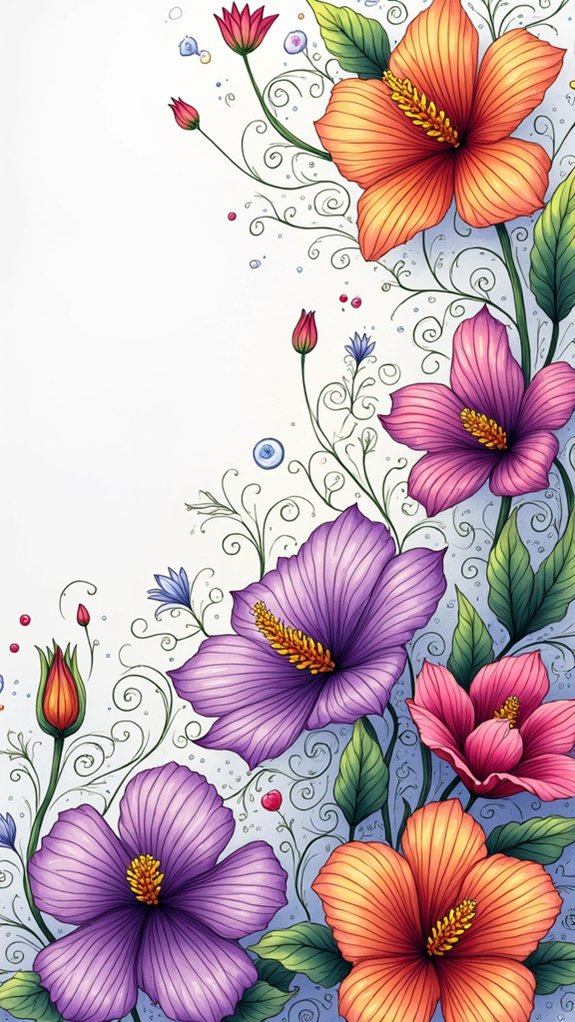
Ever wonder why floral patterns seem to pop up everywhere—on notebooks, clothes, and even those fancy phone cases? It’s because they’re the ultimate Ideas to Spark your creativity.
Floral doodles can be as easy as sketching a simple daisy or as challenging as layering petals in a bold, swirling rose. Doodlers love repeating shapes and lines, almost like a hypnotic dance that calms the brain and adds detail to the art.
Try outlining your blossoms in black ink, then fill them with wild, vibrant colors—chances are, the contrast will practically jump off the page!
Color theory sneaks into floral doodles too. Mixing complementary shades brings serious pop. Geometric shapes or abstract petals let everyone put their own twist on classic flowers—no green thumb required!
Cactus Sketches
Drawing cacti might sound prickly, but it starts with just a few easy shapes like circles, ovals, or bumpy lines—seriously, anyone can give it a shot.
Whether someone wants to sketch a giant saguaro waving its arms or a little cactus with wild patterns and big silly flowers, there are loads of cactus styles just waiting to be explored.
Some people even add sunglasses or mustaches to their doodles, because who says cacti can’t be funny?
Simple Cactus Drawing Steps
If someone’s ever wished they could draw a cool-looking cactus but didn’t know where to start, they’re in for a treat.
Begin by drawing a simple oval—think of it as the main chunk of a cactus just waiting to be decorated. Next, add a few smaller ovals as cactus arms; these give it that classic, funky silhouette that looks right out of any cactus habitat.
For realistic cactus textures, use straight lines poking out from the body—those spines are the real deal! Sprinkle in some tiny circles or star shapes on top for flowers or fruit, adding pops of cactus colors like pink or yellow.
Finish up by outlining everything with a black pen, erasing extra lines, and coloring in greens and browns. Voila!
Exploring Unique Cactus Styles
Why stick to just one type of cactus when there’s a whole desert full of unique styles waiting to spring to life on the page?
Exploring different cactus varieties can turn an ordinary sketchbook into a thriving desert scene, bursting with cool shapes. Artists can play around with basic shapes—think circles for barrel cacti or tall, skinny rectangles for the classic saguaro.
Want to amp up the fun? Try giving each cactus unique textures—scaly, spiky, or even covered in doodly flowers. Cactus colors don’t have to be just green; bright pinks, oranges, and even purple can make these sketches really pop.
Mixing styles (maybe a realistic prickly pear next to a goofy cartoon cactus) encourages creativity, and, honestly, who doesn’t want a rainbow desert?
Whimsical Fox Designs
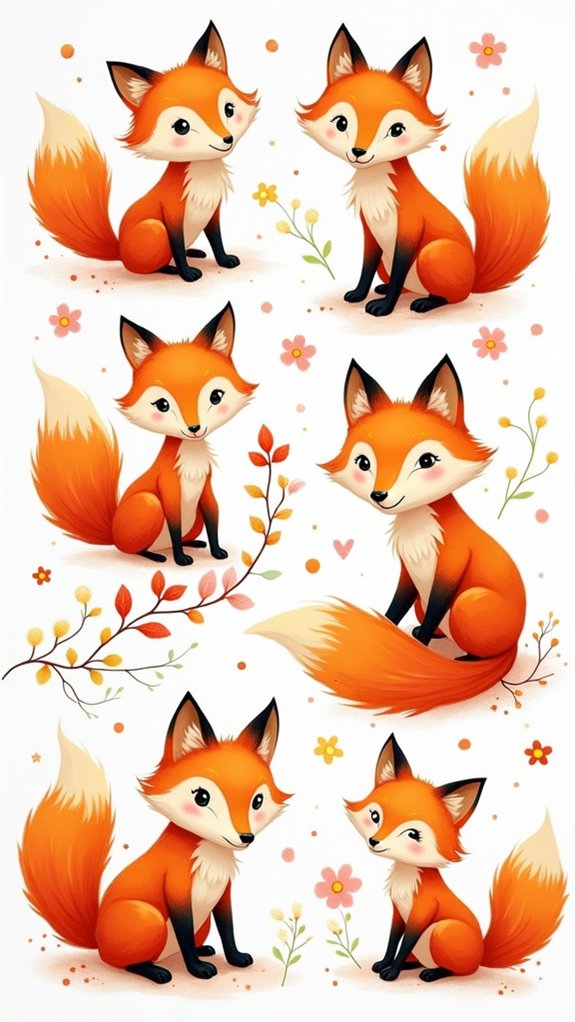
Ready for some seriously cute fox doodles?
Starting with step-by-step sketches makes it easy to build the fox’s quirky features, while adding fun patterns like zigzags or tiny hearts gives your drawing loads of personality—maybe even enough to make the other doodles jealous.
Get your pencils (and giggles) ready, because these whimsical foxes are about to steal the page!
Step-by-Step Fox Sketches
Jump right into the world of whimsical fox sketches by starting with just a simple oval for the head—it might not look like a fox yet, but that’s half the fun!
Next, add those classic pointed ears and a little triangle snout to start shaping your playful character design. Who knew a few triangles and circles could build such a cute creature?
The body and legs can also be made with easy geometric shapes, letting you make your fox chubby, long-legged, or just totally unique.
Don’t forget the bushy tail and those big, expressive eyes—they’re perfect for showing off whimsical animal expressions.
Now, experiment with unique fur patterns like wild stripes or silly polka dots to give your fox its own charming style before adding some color!
Adding Personality With Patterns
Patterns are like magic wands for turning a basic fox sketch into a one-of-a-kind masterpiece. With simple stripes, playful polka dots, or flowery shapes, an ordinary drawing gets a burst of personality.
Using pattern layering techniques—like adding swirls or bold geometric shapes over softer fur lines—makes the fox doodle pop with energy! Don’t forget to get wild with whimsical color combinations. Imagine a fox sporting vivid oranges and gentle browns, with a splash of cool blue or even pastel pink if you’re feeling daring.
To really make your drawing stand out, mix in some seasonal design elements. Autumn leaves swirling around the fox’s tail or frosty snowflakes on its cheeks definitely add charm.
Llama Characters
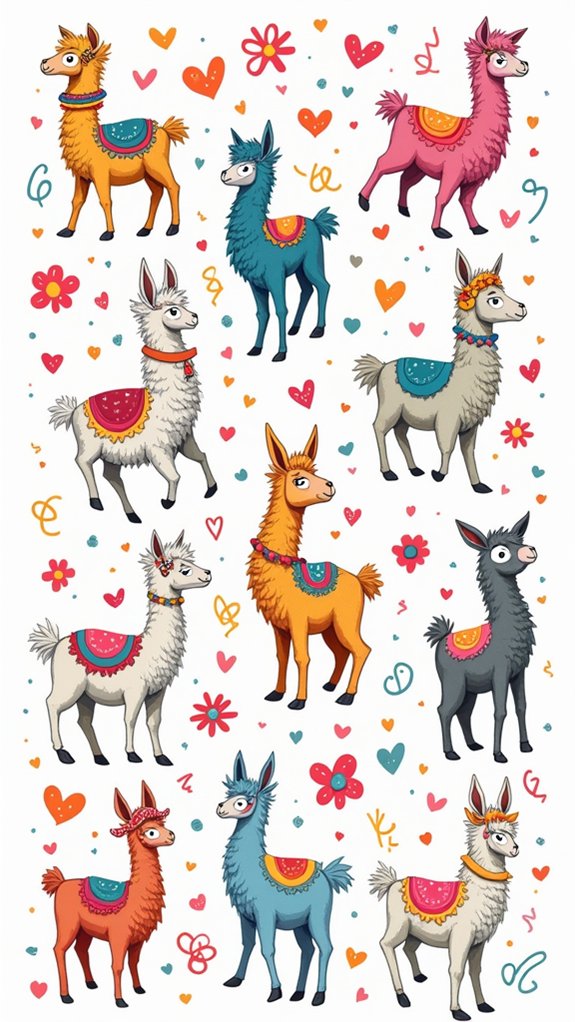
Even though llamas might seem like just fluffy animals from far-off mountains, they have a surprising way of stealing the spotlight when it comes to doodle art.
With their long, bendy necks and giant eyes, llama characters can instantly bring a sense of fun and mischief to a blank page. Dressing them up with quirky llama fashion—like polka-dot hats or funky sunglasses—can turn even a grumpy llama into the life of the party.
Plus, doodling llama adventures, from surfing on a leaf to hiking up imaginary hills, adds endless storytelling options. And don’t forget the wide range of llama expressions—they can look thrilled, shocked, or totally chill.
- Add accessories for extra personality
- Mix up styles: cartoon, realistic, or abstract
- Create themed backgrounds for wild adventures
Leaf Motifs
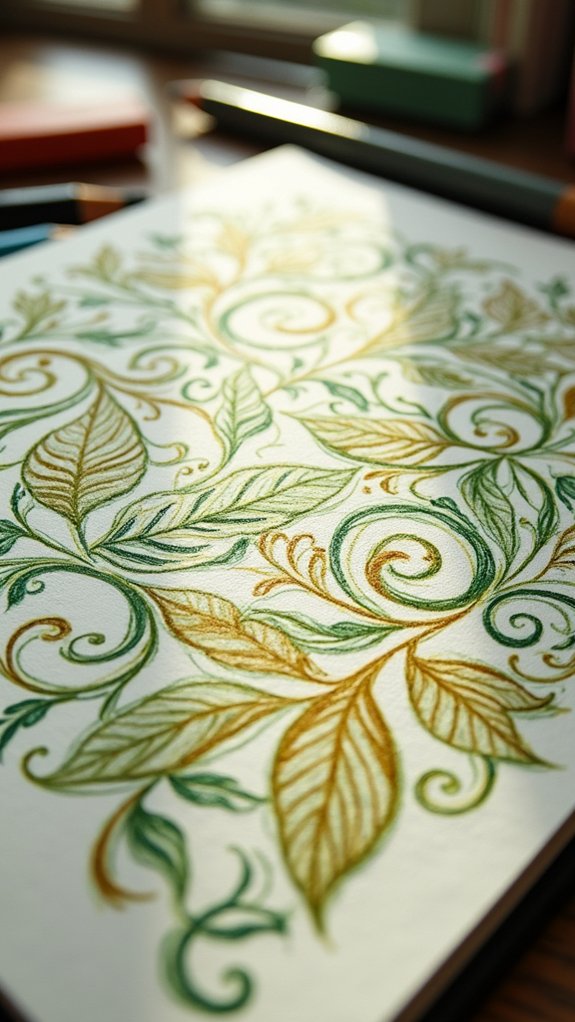
Leaf motifs are perfect for doodlers who love to play around with shapes—one minute you’re sketching a skinny, pointy willow leaf, and the next it’s a big, bold maple with jagged edges that means business.
Throw in a few lines, zigzags, or even some wild cross-hatching, and suddenly your leaf isn’t just flat—it’s bursting with texture you almost want to touch.
With so many ways to mix up the outline and fill in the details, exploring leaf doodles can feel like collecting treasures in a secret garden (just with less dirt under your nails).
Exploring Leaf Shape Variations
Take a look outside, and it’s amazing how many different leaf shapes you’ll find—seriously, they’re like nature’s wild hat collection. Leaves can be lobed, serrated, or just plain oval, and every single shape can totally transform a doodle.
Mixing up leaf shape variations in your sketchbook opens up endless possibilities, especially when you start playing with leaf color palettes and seasonal leaf designs—think fiery reds for fall or fresh greens for spring.
And don’t forget about clever leaf texture techniques! All of these add flavor to your doodles, making each one unique.
- Different shapes create fresh patterns and energy, so no two doodles have to look alike.
- Playing with real-life leaf references leads to new ideas and personal style.
- Sketching leaves can be seriously relaxing, almost like leafy yoga.
Adding Texture With Lines
Punch up any plain leaf doodle by playing with lines, and suddenly, simple sketches start to look way more awesome.
Try using line thickness techniques to bring your leaf motifs to life—thicker lines can show a strong center, while thin ones make delicate edges.
Don’t stop there! Add cross hatching shadows by layering crisscrossed lines wherever the leaf needs a little pop, almost like sunlight peeking through tree branches.
Feeling fancy? Throw in some stippling details along the veins for that extra bit of texture; a sprinkle of dots can make even a cartoon leaf feel realistic.
Mix up your line direction, try wavy or zigzag lines, or blend smooth curves with sharp angles to mimic cool, quirky natural patterns—your doodles will thank you.
Mushrooms in Nature
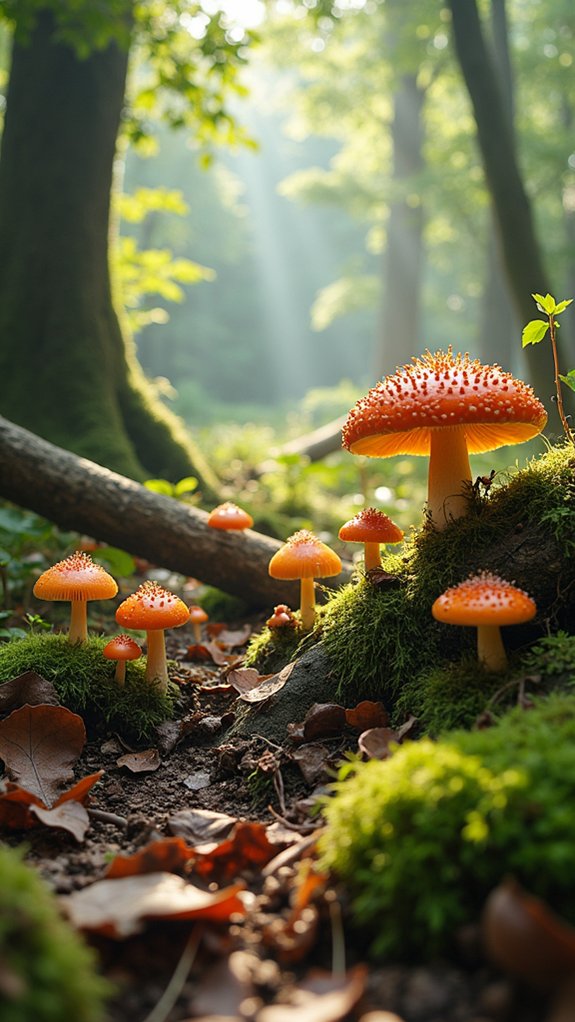
Mushrooms are like the secret surprises of the forest floor, popping up everywhere from wild woodlands to backyard gardens when you least expect them.
With over 10,000 mushroom varieties—some with polka-dot caps, zigzag gills, or wild, spiky shapes—there’s never a dull moment for doodle fans. These little wonders almost beg to be captured in a sketchbook, inspiring artists to try all sorts of doodle techniques.
Want to make them pop even more? Color experimentation lets artists go from classic earthy browns to funky purples and electric blues.
- Mixing realistic textures with silly cartoon faces brings mushrooms to life in a funny, memorable way.
- Observing their unique shapes sparks endless creativity for doodles.
- Playing with colors captures their magical vibe and keeps each sketch fresh.
Palm Tree Scenes
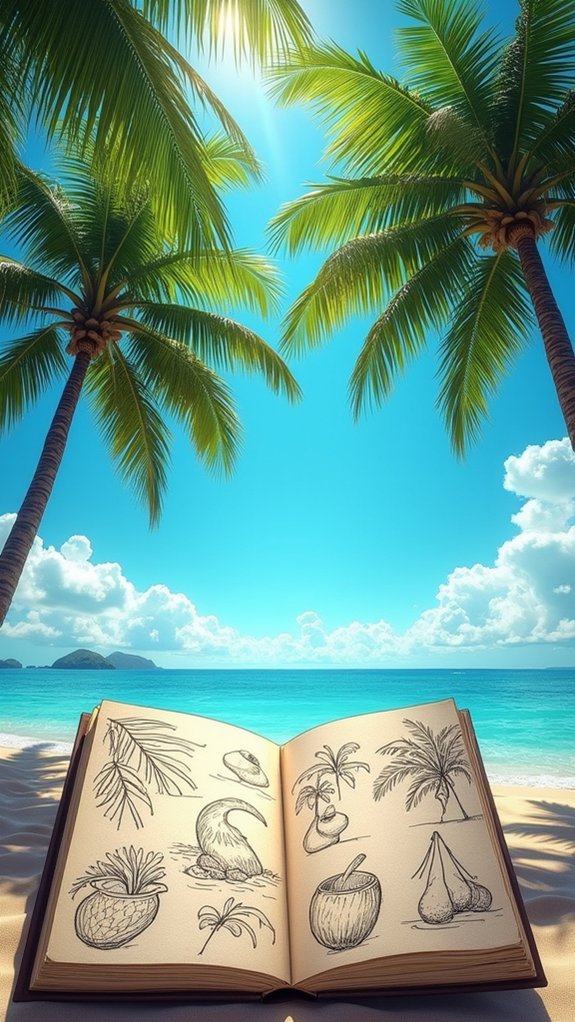
Palm trees always seem to carry a little bit of vacation magic with them, whether they’re swaying on a beach in the middle of summer or popping up as doodles on a page.
Drawing palm tree scenes can relax your mind and send your imagination straight to tropical vistas in no time. Start with simple shapes—an oval trunk, skinny teardrop leaves—and go wild exploring different palm tree varieties.
Maybe yours has a thick trunk or a skinny one that looks like it’s barely holding up those giant leaves!
Mix things up by adding colorful sunset backgrounds, with warm oranges and pinks blending behind the palms. Don’t forget some fun details like coconuts or silly birds perched above, bringing those mini vacations to life right on paper.
Pineapple Illustrations
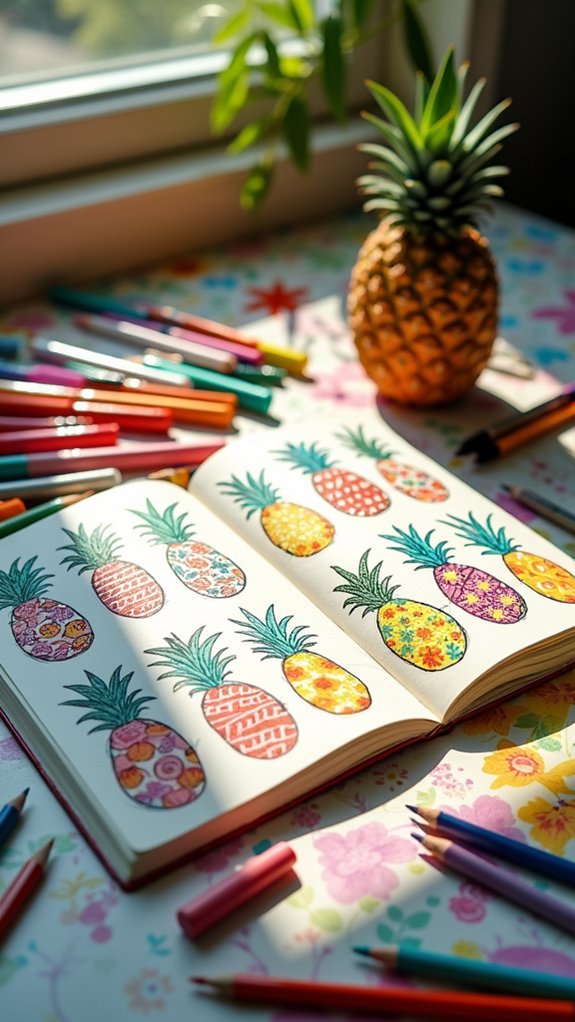
Pineapple illustrations are a blast to try, and honestly, they start with some pretty easy steps—think a big oval for the fruit and a wild, spiky crown on top.
Once that’s done, the fun really picks up when you start adding patterns or go bold with colors like yellow, green, or even a wild pink if you’re feeling rebellious.
With just a few simple moves, anyone can whip up a doodle that feels sunny, silly, and totally one-of-a-kind.
Simple Pineapple Sketch Steps
Even if someone isn’t exactly a master artist, sketching a cheerful pineapple can be surprisingly fun and easy—no art degree required!
To start, just draw an oval with a slight taper at the bottom. That’s your pineapple’s body, ready for all the fruity action.
Next, grab your pencil and sketch a bouncy zigzag across the oval. Those lines will help show off cool pineapple texture techniques—just like the diamonds on real pineapples.
Now, crown your masterpiece with spiky leaves, mixing up their lengths for that wild, tropical vibe. For extra flair, try some pineapple color variations and gentle shading to make it pop.
If you crave even more pineapple doodle inspiration, remember:
- Texture brings food sketches to life
- Variations make each drawing unique
- Creativity always beats perfection
Colorful Pineapple Doodle Variations
After sketching out a basic pineapple, it’s where the real fun begins—color! Suddenly, that tropical fruit comes alive as you break out yellows, greens, and maybe even a wild pink just for laughs.
Art techniques like blending colored pencils, layering with markers, or adding watercolor splashes help give your pineapple doodles depth and zing.
Want to amp up the fun? Try playful designs by drawing stripes or goofy polka dots on the outside, or slap on a pair of sunglasses. Maybe even add a big, goofy smile.
Using mixed media lets each doodle feel different, almost like giving that pineapple its own personality. With so many options, making pineapple doodles is pretty much a one-way ticket to a good time.
Book Stacks and Open Pages
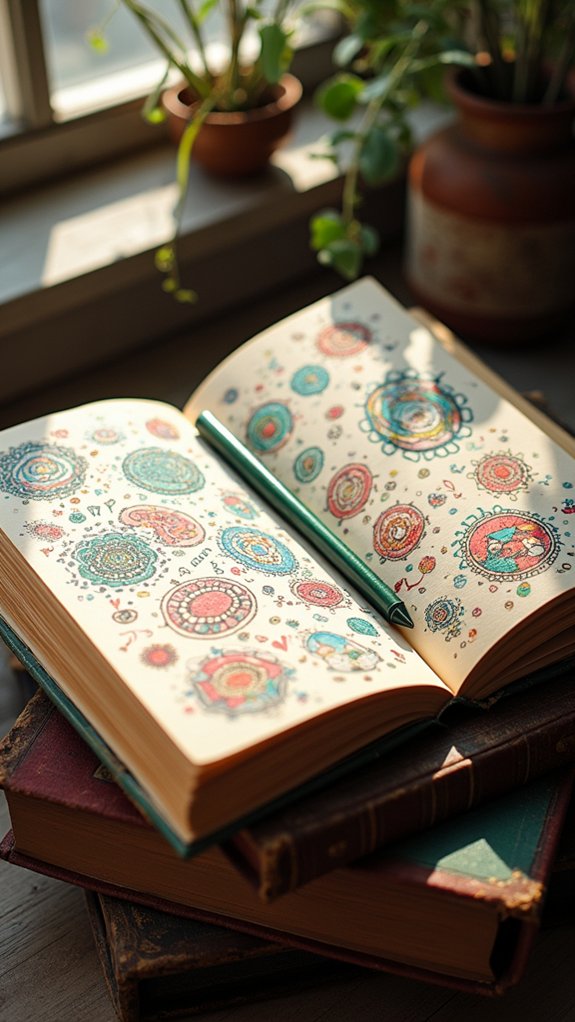
Books, with all their stacked-up stories and secrets, make awesome subjects for doodling, especially when aiming to boost creativity.
Drawing book stacks can be as simple or as fancy as you want—maybe just a pile of rectangles, or maybe shelves packed with wild book cover designs and curious book spine textures.
Open books, with their fluttery pages and gentle curves, invite you to scribble your favorite quotes across the spreads or even doodle tiny illustrations in the margins.
Color can totally transform these sketches. Try adding bold hues to the covers or a shadow beneath the stack for dramatic effect.
Check out some ways to make your book doodles pop:
- Decorate book spines with unique textures and colors
- Fill open pages with inspiring favorite quotes
- Mix hardcover and paperback styles for variety
Watercolor Birds
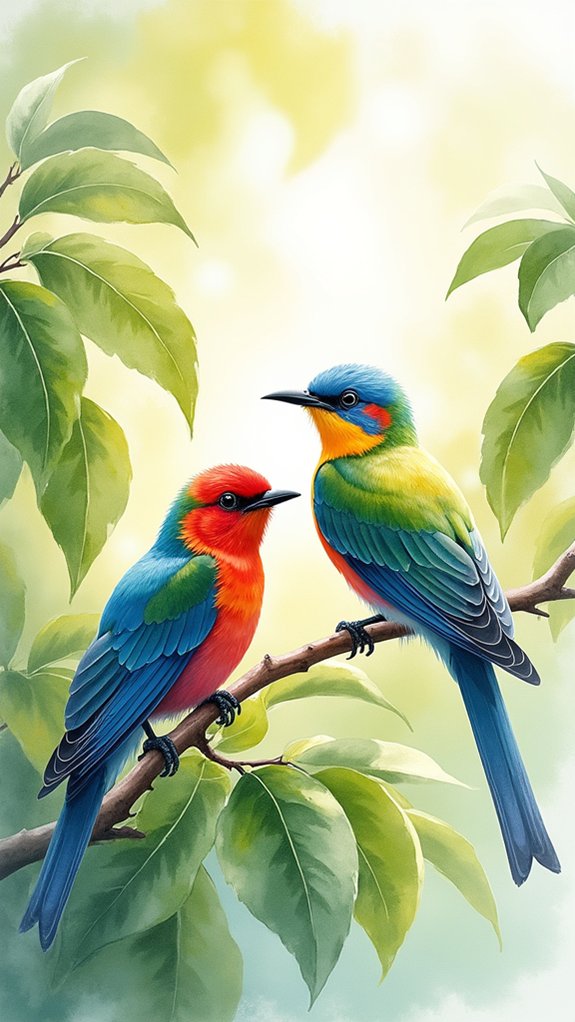
Watercolor birds bring a splash of color and life to any art project, almost like letting a little magic loose on the page. Artists can experiment with wet-on-wet watercolor blending methods to get those dreamy, blurry edges that look just like feathers in motion. To capture avian movement, try fast, sweeping strokes for the bird’s body and quick flicks for the wings and tails—it’s almost like giving your bird a burst of energy! Using light shades for highlights and deeper tones for shadows makes your birds pop off the paper. Throw in some pastel blues for a sky background, and you’ve got a scene that feels alive. Here are some ideas:
| Bird Species | Flight Technique | Color Blending |
|---|---|---|
| Hummingbird | Hovering | Soft Green-Purple |
| Swallow | Swooping | Blue-Gray Mix |
| Kingfisher | Diving | Orange-Teal Splash |
Mountain Silhouettes
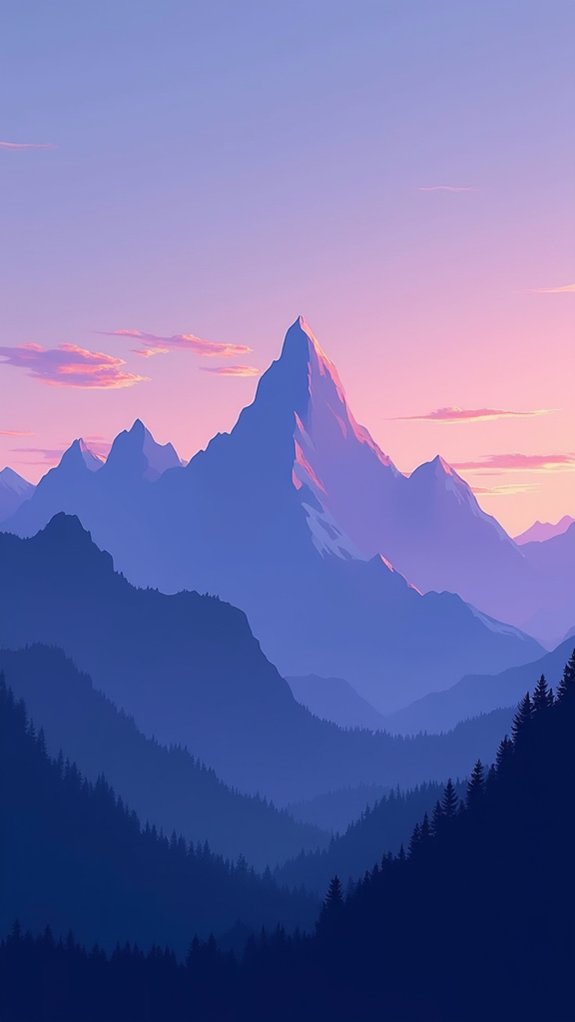
Even when a doodle is super simple, mountain silhouettes can pack a surprising punch—sometimes all it takes are a few bold, craggy lines to turn a blank page into something dramatic.
Using mountain perspectives and silhouette techniques, artists can play with terrain contrasts by emphasizing sharp peaks or layering different ranges. The trick is to mess around with line weights: thick ones for the closest mountains, thinner for those far away—instant depth!
Adding shadows with shades of gray or blue? Chef’s kiss! And don’t forget tiny trees for that wow factor in scale.
- Explore multiple mountain perspectives to show depth and vastness.
- Use varying line weights in silhouette techniques to highlight terrain contrasts.
- Frame your doodle for a polished, eye-catching effect.
Suddenly, simple lines spell adventure!
Crescent Moons With Flowers
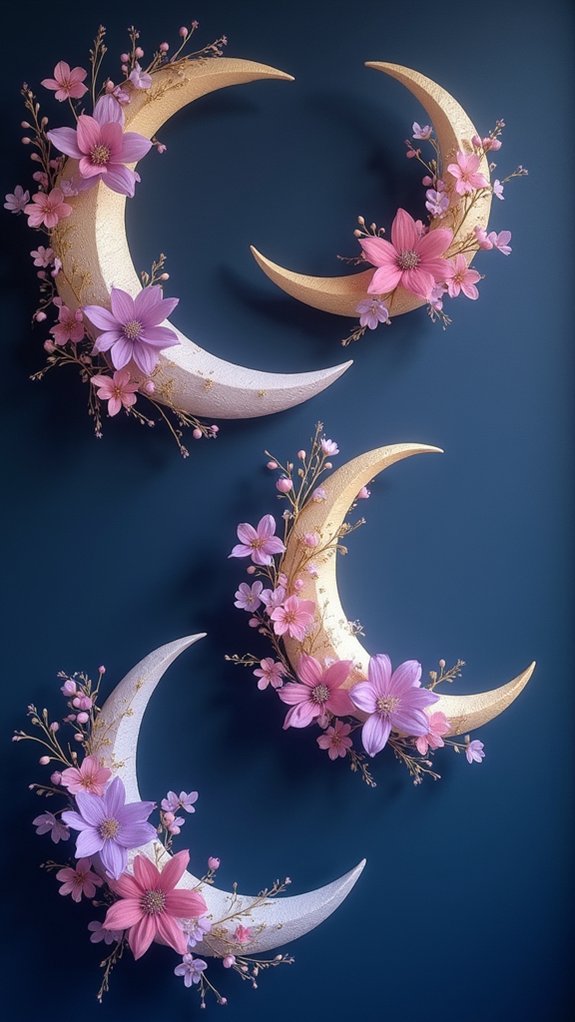
After exploring the wild drama of mountain silhouettes, it’s time to switch up the vibe and get a little magical.
Envision this: a crescent moon hanging in the night sky, its curve blooming with roses, daisies—maybe even some wild, weird blossoms you invent yourself. It’s like doodling inside a moonlit garden, where flowers and stars throw a party together.
Add some extra detail and suddenly you’ve got a sky full of floral constellations and celestial blooms! Incorporate different flower styles, from realistic petals to crazy cartoon twirls, and watch your page turn into something dreamy.
Try different colors and a bit of shading for extra pop. Prompts like these push you to blend cosmic coolness with earthy, flowery fun—magic every time.
Geometric Mandalas
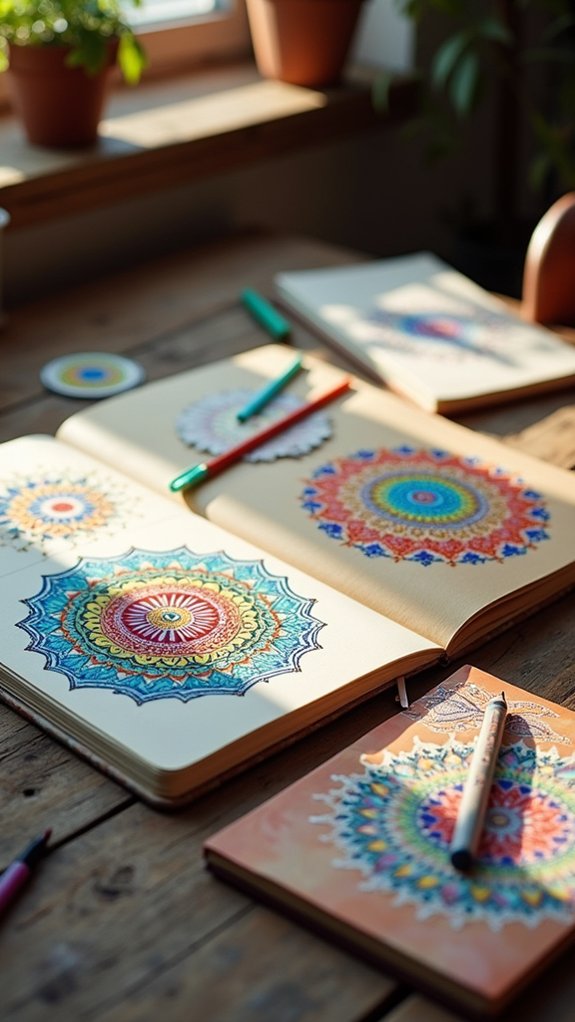
Whenever someone starts doodling a geometric mandala, it’s like building a universe from one tiny point in the middle of the page. Circles, triangles, and squares start popping out, spinning around that dot, kind of like hypnotized planets doing a super organized dance.
Mandala symmetry techniques help each part match up perfectly, and with the right tools—a ruler, a compass, maybe a little patience—even the messiest hand can create something stunning.
Doodling geometric shape variations isn’t just about straight lines and neat corners, though. It’s a mindful doodling practice that can make you feel seriously calm, even if your math homework is calling your name.
- Mandala symmetry techniques boost precision and order.
- Geometric shape variations inspire creativity.
- Mindful doodling practices reduce stress.
Minimalist Cat Outlines
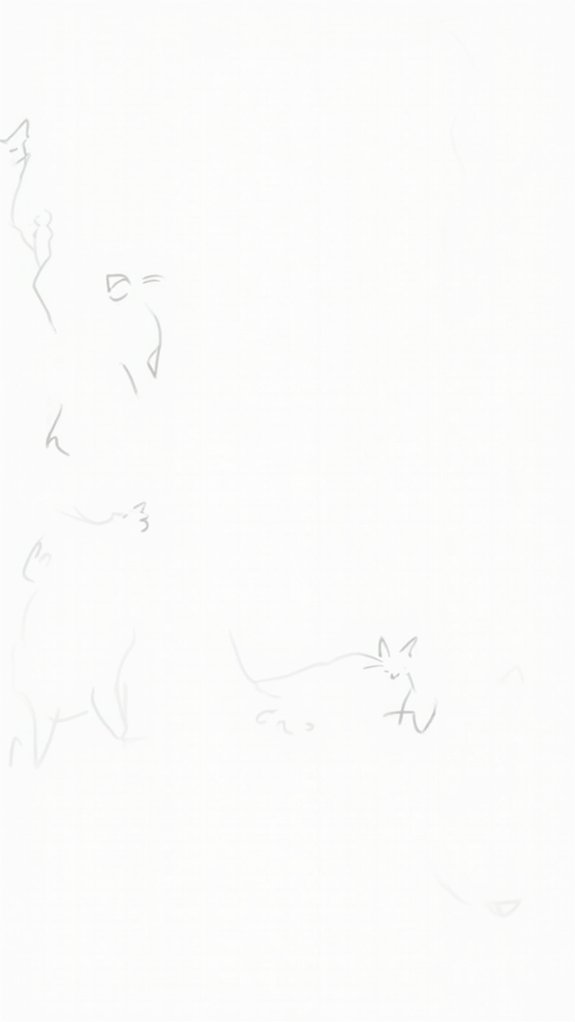
Simplicity can sometimes steal the show, and that’s exactly what happens with minimalist cat outlines. With just a few clean, swooping lines and a careful curve or two, these doodles capture cat personality traits—like curiosity or sleepiness—without any fuss.
It’s pretty cool to see how much emotion you can pack into the tilt of some whiskers! Minimalist art techniques, like using monochrome or soft pastels, really help keep the focus on those iconic kitty shapes.
People often draw inspiration from real cats or online doodle inspiration sources, and it’s awesome how such simple shapes can become the star of a journal page, card, or poster.
Best part? Practicing these doodles actually sharpens your own artistic eye—plus, they’re purrfectly fun!
Honeybee Details

Honeybees are awesome little creatures to doodle, with so many cool parts to sketch—think their fuzzy bodies, see-through wings, and those fancy stripes that make them stand out.
Adding funny faces or a super serious bee expression can totally change the mood of your drawing and make it pop with personality.
Whether you try perfect wings or goofy smiles, focusing on these tiny details can make your honeybee doodles not just cute, but seriously impressive.
Anatomy of a Honeybee
Picture an insect that looks like something straight out of a tiny science fiction movie—this is the honeybee, built with absolutely wild features designed for its busy life.
Take a closer look, and you’ll find bee anatomy features that seem almost futuristic: two pairs of shimmering wings, huge compound eyes made of thousands of mini-lenses, and legs loaded with pollen baskets.
These little marvels aren’t just busybodies; they’re part of a super-organized honeybee social structure where every bee has its own job.
And let’s not forget their awesome pollination process benefits, helping flowers bloom and veggies grow. Wild, right?
Even their tiny tube-like mouth, called a proboscis, is engineered to sip nectar like a sophisticated straw.
- Compound eyes see ultraviolet!
- Teamwork rules the hive.
- Pollination keeps planet Earth thriving.
Wing and Stripe Patterns
Wings and stripes are where honeybees really show off their sense of style. The wings are like delicate stained glass windows, brimming with wing symmetry thanks to those crazy-intricate veins and see-through patches.
Doodlers can totally run wild here, layering geometric inspiration—triangles, diamonds, or wild zigzags—right onto the wings, giving them both structure and flair.
Then come the stripes. No two honeybees show off the exact same stripe variations! Sometimes it’s bold, chunky bands; other times, skinny lines sneak between the wide ones.
Playing with curvy versus straight lines in each stripe, or messing with how thick or thin a band can be, really makes a doodle pop.
Basically, give your bee some pizzazz and let those patterns sing!
Doodling Bee Expressions
Not every bee needs the same old blank face—why not crank up the personality? Doodling bee expressions is all about giving your honeybees some attitude and charm.
Try sketching out big surprised eyes, goofy grins, or even a slightly smug smirk to capture different bee emotions. Adding tiny details like flicking antennae or expressive wings makes these buzzing poses feel even more alive.
Then, pop your bees into floral backgrounds or near a hive for some extra story power. Play with color—sharp yellows, bold blacks, and soft flower shades can help your bee doodles stand out and feel vibrant.
- Mix expressive faces and bee emotions for unique personalities
- Use buzzing poses for dynamic movement
- Place bees in floral backgrounds for context and fun storytelling
Abstract Face Line Art
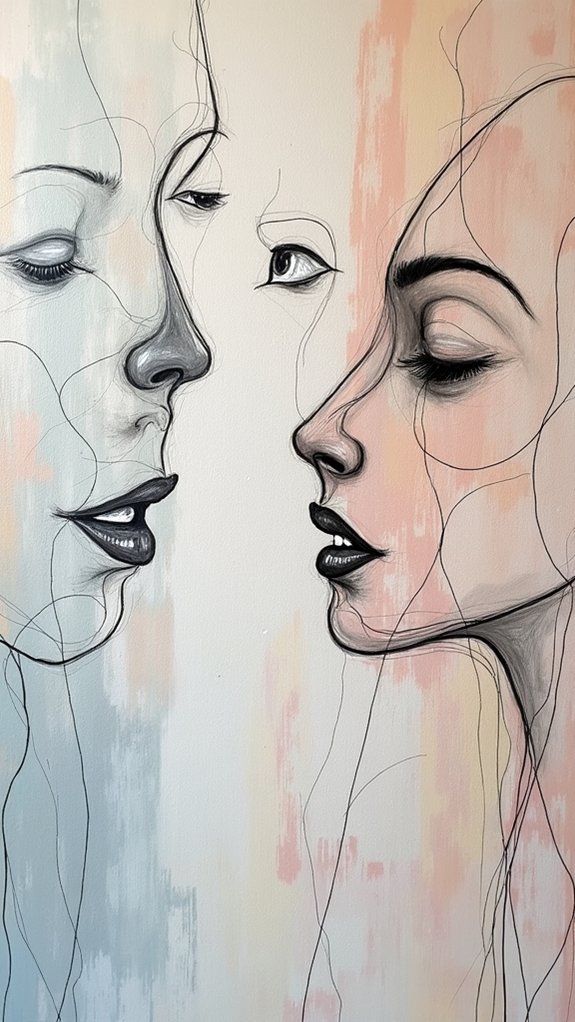
Abstract face line art might sound fancy, but really, it’s just about using one continuous line to create a face that’s more about personality than perfection.
Think of it like doodling faces without worrying about getting every detail right—just let your pen flow. Artists have a blast playing with line thickness variations, making some lines bold and others whisper-thin. This can totally change how dramatic or chill the face looks.
There’s also an emotional expressions exploration part—one squiggle and suddenly your face looks curious, surprised, or just plain goofy.
Want more? Try mixed media experimentation by throwing in pops of color or a little collage. Whether you’re sharing online or just having fun, abstract face line art makes creativity feel easy and exciting.
Vintage Typewriters

If faces drawn with a single, swoopy line can spark imagination, just imagine what a seriously cool old-school typewriter can do. Vintage typewriters are full of typewriter aesthetics—ornate keys, worn brass, and that mechanical nostalgia you can almost hear as the keys clack.
There’s something magical about the way levers and hammers work, turning thoughts into visible words. For doodlers, these machines are more than retro objects—they’re creative prompts waiting to happen.
Want to get ideas flowing? Try sketching:
- The famous round keys or a typewriter’s quirky silhouette
- A ribbon twisting into poetic words or wild shapes
- An explosion of letters bursting from the paper, each filled with tiny drawings
Vintage typewriters are all about inspiration—why not let them start your next creative journey?
Paper Airplanes
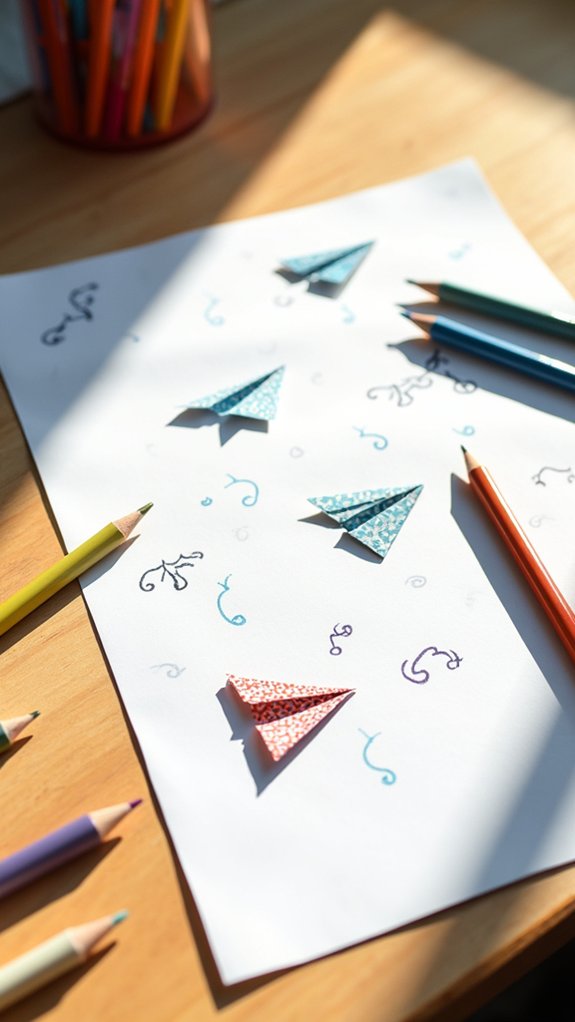
Launch creativity into the clouds with paper airplanes—possibly the easiest doodle with the biggest possibilities.
Imagine sketching a simple triangle, then letting your imagination take over with creative folding techniques, even if you’re only drawing them! Try zig-zag wings or fold lines drawn in for extra detail.
Add some whimsical airplane embellishments, like funny faces, goggles, or racing stripes. Who says paper airplanes have to be boring? Give them bold colors or watercolor splashes for a dramatic spin.
Surround your creations with playful background elements, like doodled clouds and distant birds, to make the scene feel alive and full of movement.
Every paper airplane is a fresh adventure, soaring into new skies—no airport security line required. Just pure, jet-powered doodle fun!
Floating Lanterns
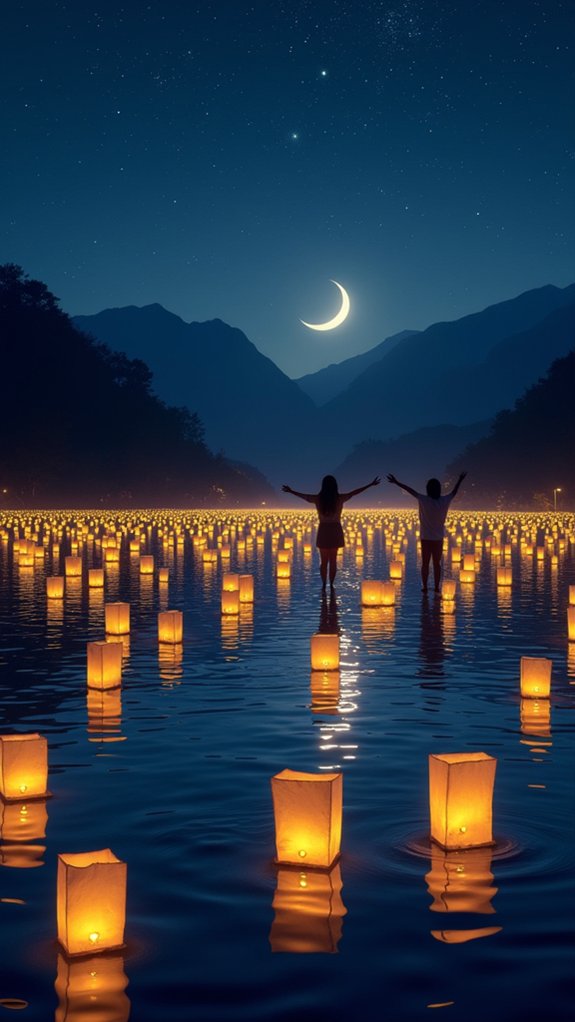
Magic fills the air whenever floating lanterns show up in a doodle. These glowing shapes aren’t just beautiful—they’re overflowing with lantern symbolism, representing hope, dreams, and the letting go of worries.
Their festival origins, especially the breathtaking Lantern Festival in China, make drawing them even more special. If you want to get creative, try these artistic techniques: start with an oval for the top, then draw a gentle, tapered body. Don’t forget a little flame at the top! Warm yellows, oranges, and reds bring a sense of celebration and whimsy.
- Lanterns release wishes—give your doodle some hope.
- Reflecting lanterns on water adds depth and calm.
- Grouping different colored lanterns creates a lively festival vibe.
Float those doodles sky-high!
Hummingbird in Flight
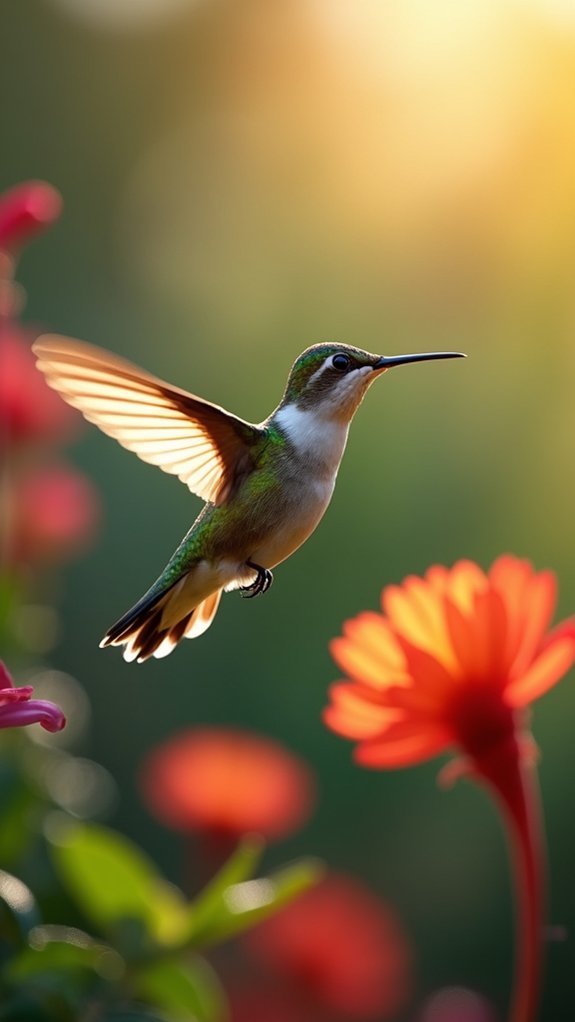
Drawing a hummingbird in flight is all about showing motion, so using quick, sweeping lines can make the wings look like they’re buzzing in midair.
Sometimes, keeping the doodle simple—just a few lines and shapes—works even better to capture speed and energy, almost like the bird is too fast to catch!
Tiny touches, like squiggly feathers or a flick of color on the throat, add that extra sparkle, making the little bird pop right off the page.
Capturing Motion With Lines
There’s something seriously awesome about trying to capture a hummingbird in flight—these tiny birds move so fast, it’s almost like they’re defying the rules of nature.
When drawing them, using clever motion techniques is the way to go. If you want your doodle to show off that crazy speed and energy, try sweeping, dynamic shapes for the wings and body. Mix things up by adding line variation—thicker lines for the bird’s core and quick, skinny strokes for those blur-fast wings.
Even adding some trailing lines or blurred marks behind the bird can crank up the action, making it look like it’s zooming by.
- Try bold, curved lines for graceful movement
- Short, sharp strokes suggest rapid wing beats
- Trailing shapes evoke a sense of speed
Minimalist Doodle Techniques
Forget cramming a ton of details onto the page—sometimes, less really is more, especially when it comes to doodling a hummingbird in flight.
Minimalist bird designs rely on sleek, fluid outlines that shouldn’t stress you out. Just grab a pencil and start with an oval for the body, sharp triangles for wings, and maybe a tiny circle for the head.
Want to make it even cooler? Try negative space techniques: leave little gaps where feathers or the eye would be, letting the blank paper do some of the work.
Experiment with a couple of soft colors and vary your line thickness—a bold body, skinny beak, and fine wing lines. These geometric animal forms make your hummingbird light as air, almost ready to zip off the page!
Adding Delicate Details
Some hummingbirds look like they just zipped straight out of a rainbow—seriously, those feathers are wild.
When doodling a hummingbird in flight, adding delicate details really brings your sketch to life. Start with gentle body curves to grab that super agile shape.
Then, go crazy with those wings—use quick, cool strokes to show their rapid movement and pack in all the intricate patterns of feathers. Don’t forget the shiny, iridescent colors; blending greens and blues makes it pop!
Little touches like the tiny beak and expressive features, especially those lively eyes, will make your doodle sing.
- Explore delicate textures for the body and wings
- Capture intricate patterns with layered lines and colors
- Highlight expressive features for personality and energy
A soft background finishes things off!
Jellyfish in Motion
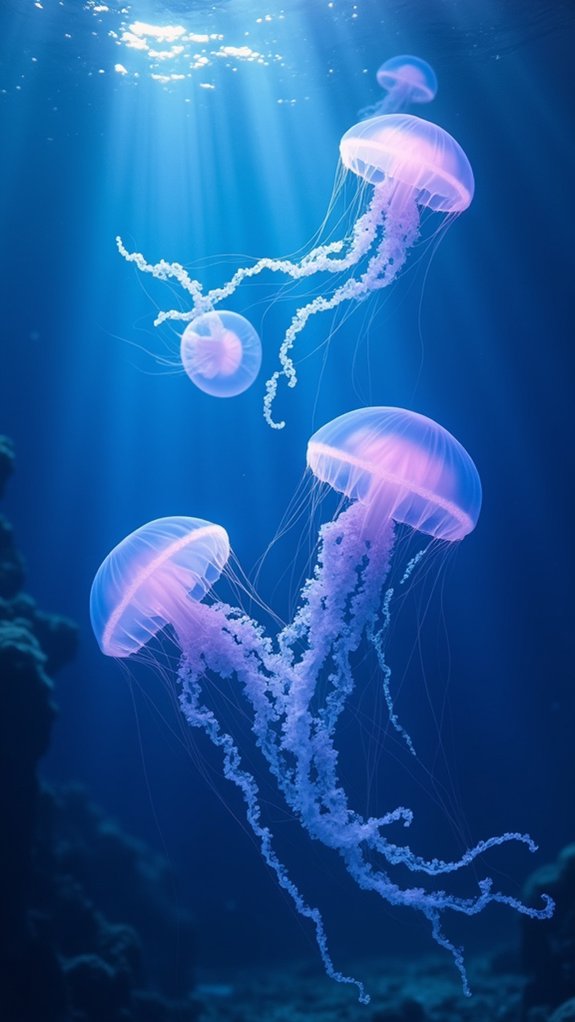
Jellyfish look like floating, squishy umbrellas, but when it comes to doodling them, they’re way cooler than rain gear.
Drawing jellyfish in motion means embracing their funky jellyfish anatomy—think wavy tentacles, a soft, rounded bell, and all sorts of bendy shapes.
To really make them pop off your page, consider underwater colors like gentle blues, dreamy pinks, and purples that shimmer like secrets at the bottom of the sea.
Fluid dynamics are key, so scribble spirals or swooping lines to capture that classic, slow-motion drift.
Try combining thin, squiggly lines for the tentacles with bolder strokes for the bell, making your jellyfish look lively and real.
Don’t forget: adding swirling patterns inside their bells can bring your doodle to life!
Retro Roller Skates
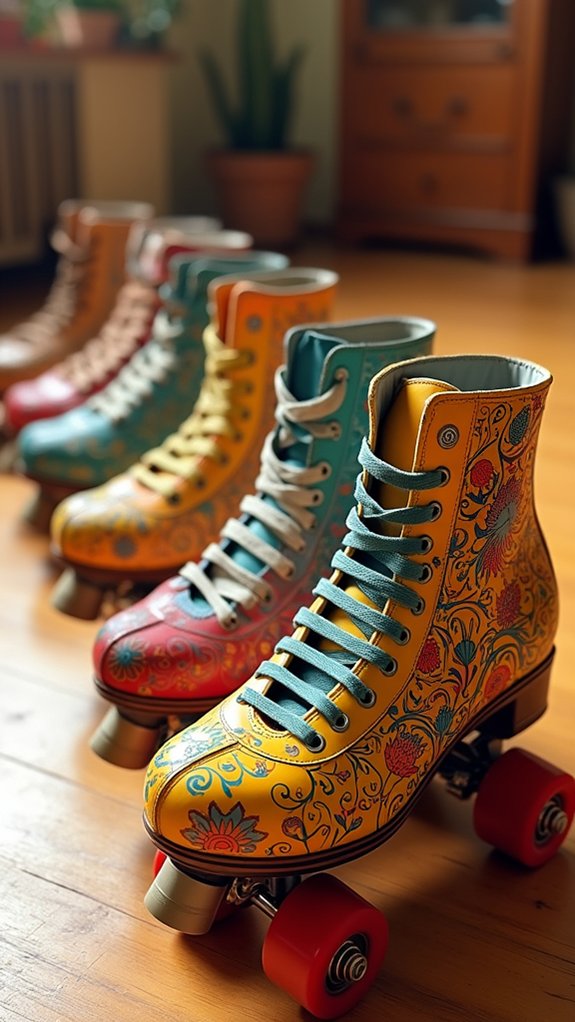
Roller skates—a blast from the groovy past—are like tiny party machines strapped to your feet, and doodling them means dialing up the fun. Bringing retro roller skates to life on paper is all about channeling the retro skateboarding culture that rocked the 1970s and ‘80s.
Start with simple shapes: rectangles for the boots, circles for wheels, and then jazz them up with nostalgic design elements. Remember those vibrant color combinations—whether it’s neon pink with electric blue or pastel purple and mint green, the bolder, the better!
Don’t forget the extras; stripes, old-school logos, and laces really pop.
- Show how energy and movement were central to retro skateboarding culture.
- Mix and match vibrant color combinations to capture that true retro vibe.
- Use nostalgic design elements for authenticity and personality.
Bamboo Groves
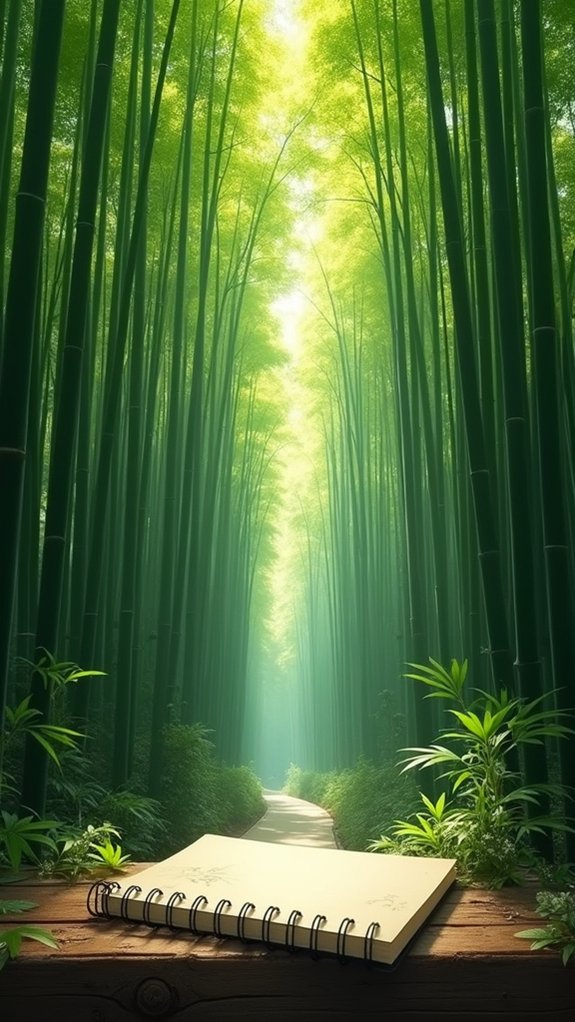
Even if someone has never wandered into a real bamboo forest, it’s easy to feel instantly calm just by doodling a bamboo grove. Bamboo art is a chill way to let your creativity flow, and these leafy giants aren’t just nice to look at—bamboo symbolism stands for resilience and peace. When doodling, simple lines and different shades of green mix together to make those tall stalks pop, kind of like sunlight peeking through real bamboo ecosystems. If pandas or birds show up in your drawing, great—they love bamboo groves too. The repetitive pattern of bamboo creates a zen, almost hypnotic effect.
Here’s a quick visual guide for doodling bamboo groves:
| Stalks | Leaves | Wildlife |
|---|---|---|
| Tall, straight | Wispy, layered | Panda munching |
| Side by side | Overlapping | Bird perched |
| Different greens | Light/dark mix | Butterfly flitting |
| Tapered ends | Breezy curves | Hidden insects |
Hot Air Balloons
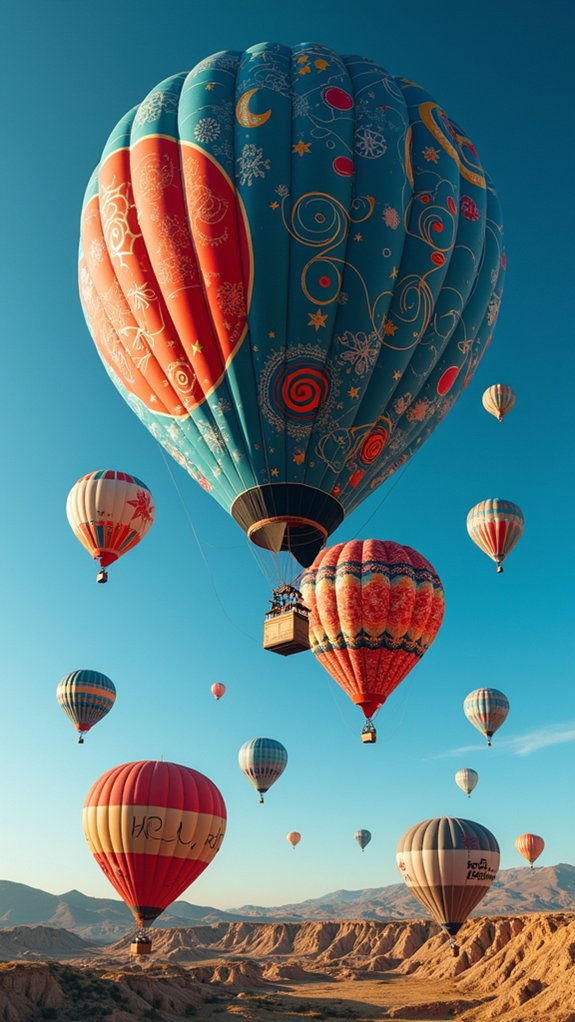
A doodle of a hot air balloon pretty much guarantees instant adventure, no ticket required.
With colorful patterns swirling across the balloon’s envelope and wild, adventurous perspectives like a view from way down below, this drawing is a mini-vacation on paper.
The real fun kicks in when imaginations take off—balloons in teardrop or round shapes, whizzing above whimsical scenery or fluffy clouds, maybe even some startled birds trying to keep up.
- Filling the surface with colorful patterns pumps playful energy into every drawing.
- Changing perspectives, like sketching the balloon from underneath, lets doodlers capture that soaring, free feeling.
- Building out the scene with clouds or tiny houses below invites viewers into a world of whimsical scenery.
Set your creativity loose and enjoy the ride!
Frequently Asked Questions
How to Make a Creative Doodle?
When considering how to make a creative doodle, one can explore various doodle techniques, draw from diverse inspiration sources, and experiment with doodle themes. This approach encourages originality, personal expression, and artistic growth within their creations.
Does Doodling Help With Creativity?
Doodling benefits creativity by fostering artistic expression and enhancing brainstorming techniques. Research suggests it stimulates cognitive function and memory retention, helping individuals generate innovative ideas while reducing stress, making it a valuable tool for creative and problem-solving processes.
How Do You Come up With Doodles Ideas?
When seeking new concepts, one might explore doodle prompts, draw from a variety of inspiration sources such as nature or daily life, and experiment with diverse art techniques, ultimately generating a consistent flow of fresh doodle ideas.
What Is Creative Doodling?
Creative doodling refers to the spontaneous practice of using various doodle techniques to create imaginative sketches. It emphasizes artistic expression without strict rules, allowing individuals to freely explore their creativity and visually communicate thoughts and emotions.
Conclusion
From bouncing jellyfish to retro roller skates, these 25 doodle ideas are like a rocket launch for your creativity. If your pencil ever feels stuck, just pick a doodle from the list and let your imagination take a detour. Don’t stress about perfection—wobbly lines and goofy llamas are all part of the magic. Drawing should be fun, a little weird, and totally you. So grab your sketchbook, start doodling, and let your creative adventure begin!

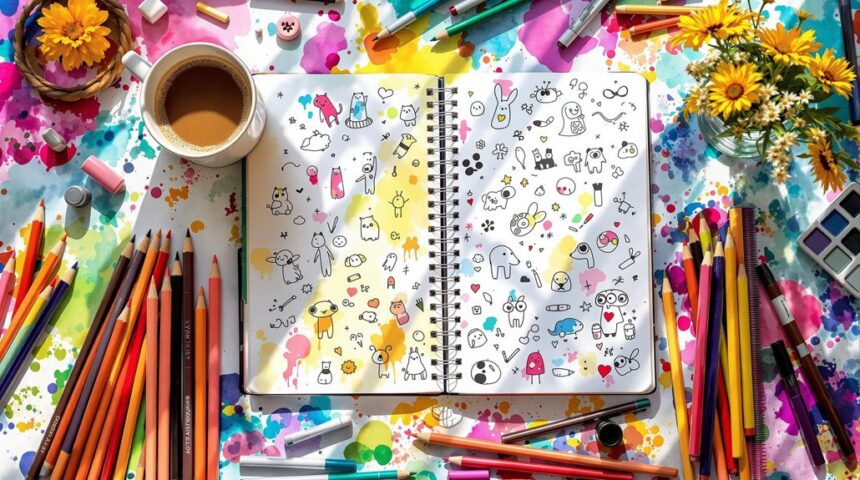
Leave a Reply